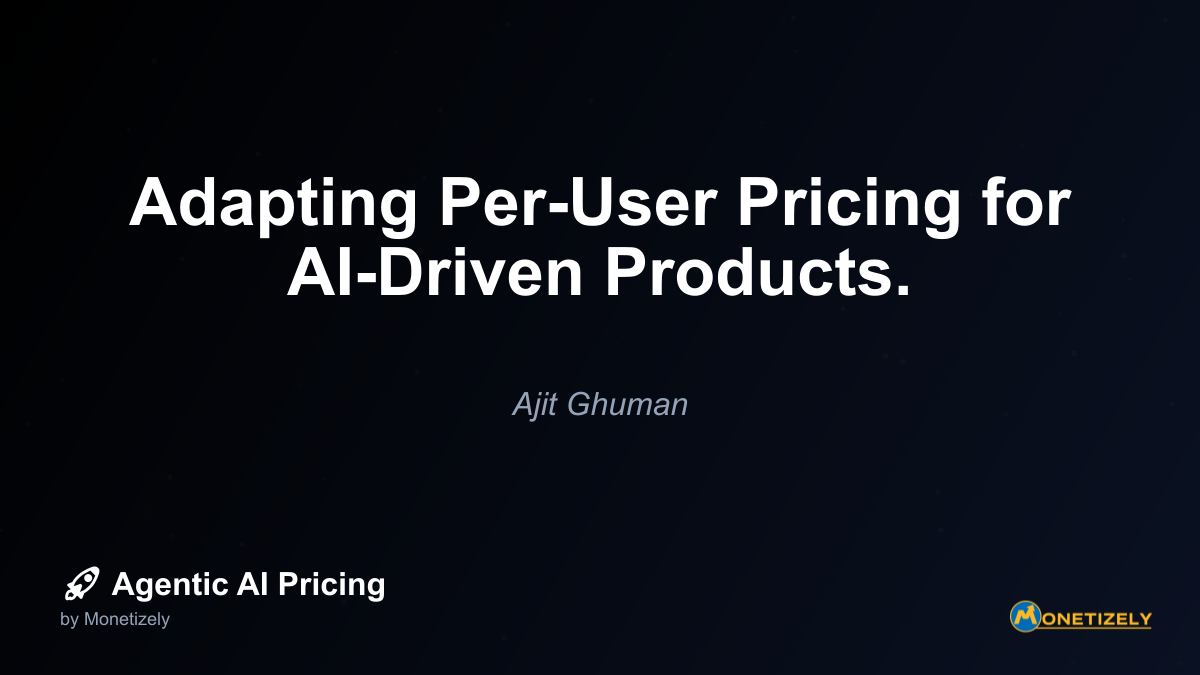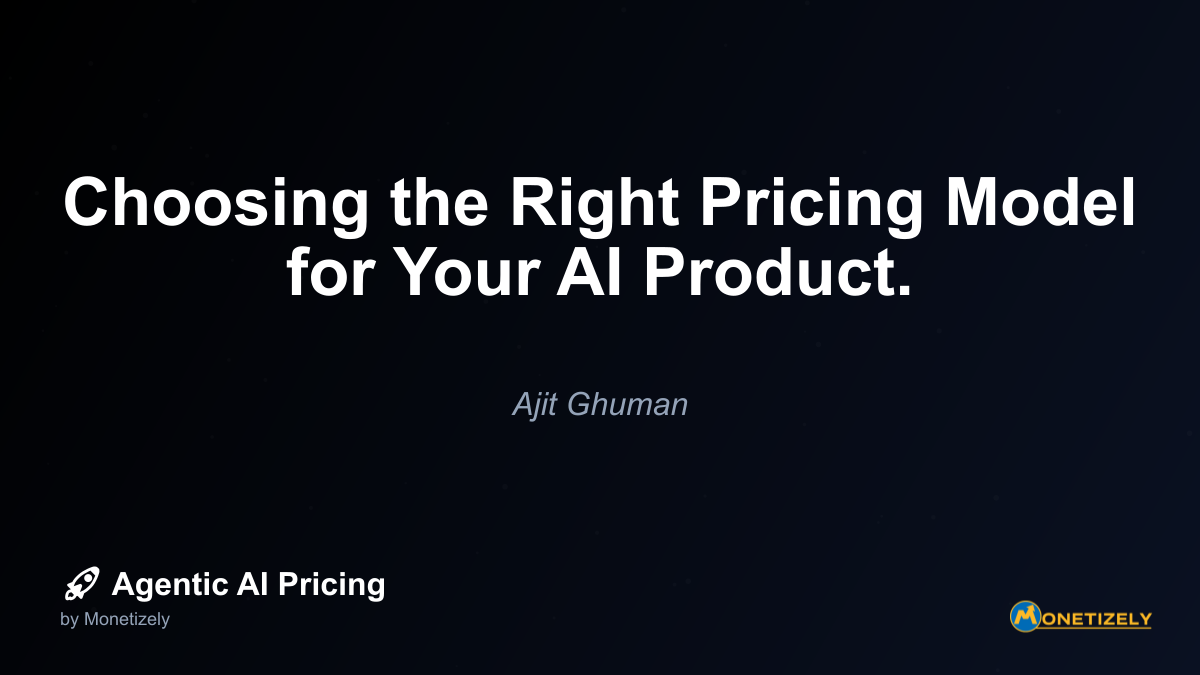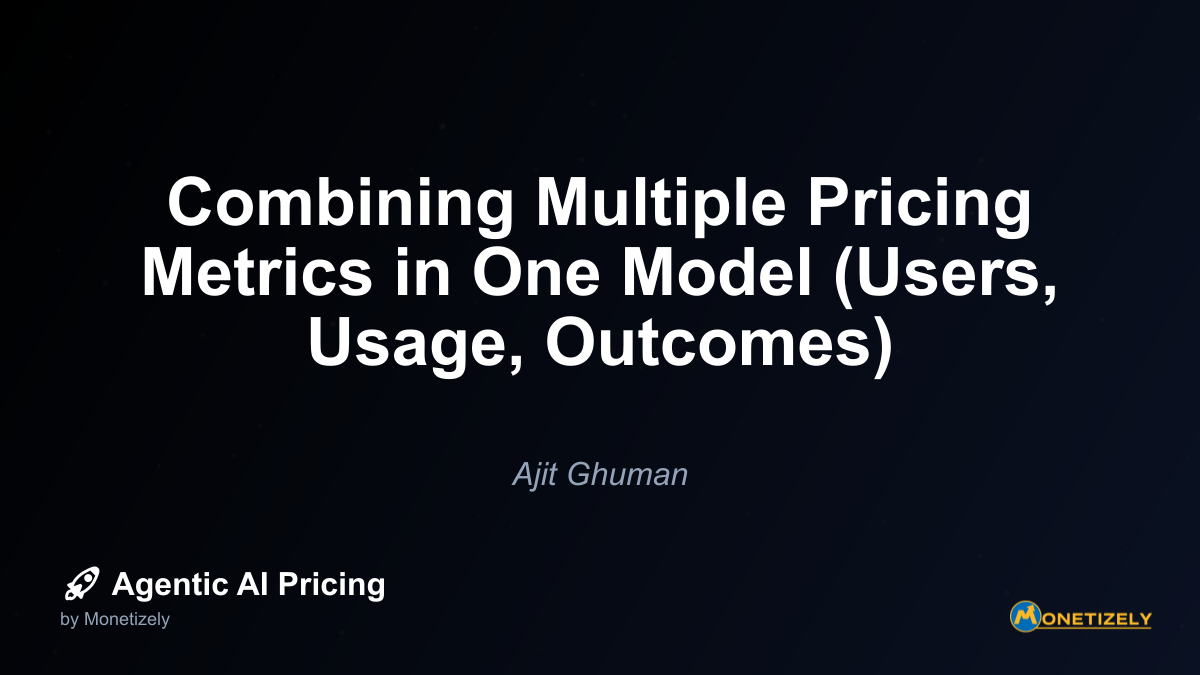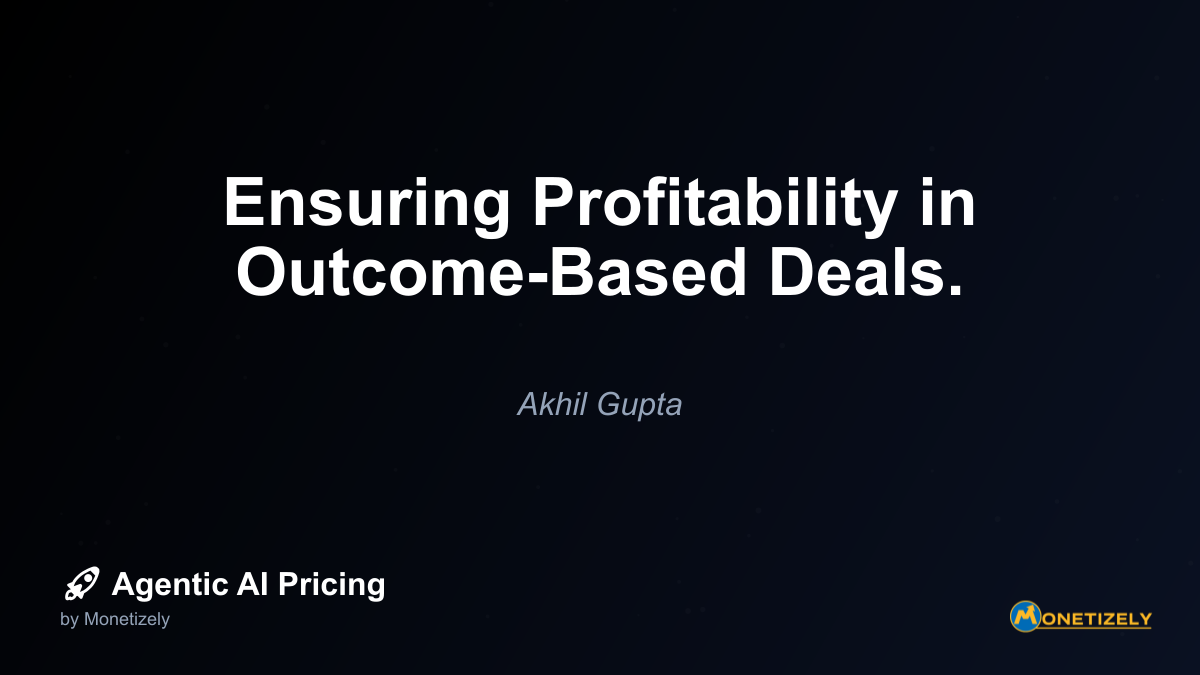· Ajit Ghuman · Agentic AI Pricing Strategies · 13 min read
Implementing Outcome-Based Contracts: What to Consider.
AI and SaaS Pricing Masterclass
Learn the art of strategic pricing directly from industry experts. Our comprehensive course provides frameworks and methodologies for optimizing your pricing strategy in the evolving AI landscape. Earn a professional certification that can be imported directly to your LinkedIn profile.
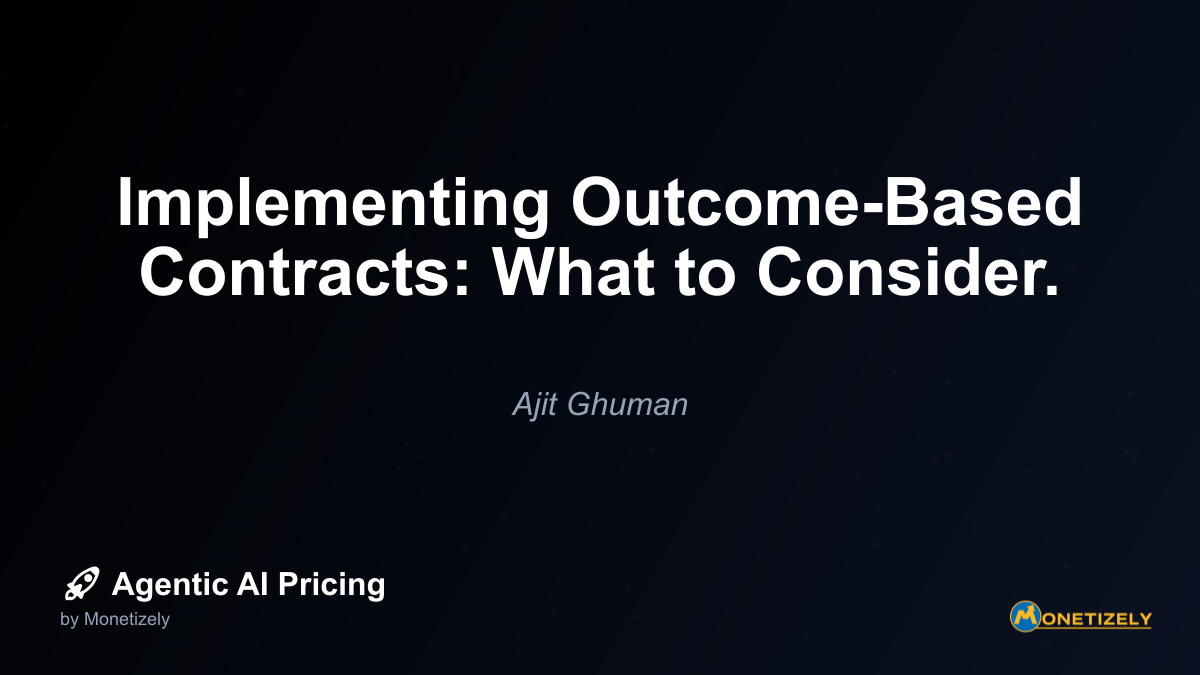
In today’s rapidly evolving AI landscape, organizations are increasingly seeking ways to align technology investments with business outcomes. Outcome-based contracts for AI projects represent a paradigm shift from traditional fixed-price or time-and-materials agreements, offering a promising approach to ensure both vendors and clients share risks and rewards. These contracts tie payment directly to the achievement of predefined business results rather than project deliverables, creating a powerful incentive structure that drives success.
However, implementing outcome-based contracts for AI initiatives requires careful consideration of numerous factors—from defining appropriate metrics to establishing fair compensation models and building in necessary safeguards. This comprehensive guide examines the practical considerations when structuring outcome-based pricing agreements for AI projects, ensuring both vendors and clients are protected while maximizing the potential for mutual success.
The Rise of Outcome-Based Contracts in AI
Traditional contracting models often fail to address the unique challenges of AI implementations. Fixed-price contracts struggle to accommodate the inherent uncertainty in AI development, while time-and-materials agreements provide little incentive for vendors to deliver business value efficiently. As AI technologies mature and organizations prioritize ROI, outcome-based contracts have emerged as a compelling alternative.
According to recent market analysis, outcome-based contracting is gaining significant traction as companies seek to align AI project costs with realized business value. This approach reduces upfront risk while creating shared incentives for project success. The evolution of AI’s capabilities in contract management further supports this trend, with predictive analytics now able to forecast contract performance, vendor risks, and compliance issues—enabling smarter outcome-oriented terms.
Smart contracts and blockchain technology are accelerating this shift by facilitating outcome-based terms through real-time performance tracking and automatic verification. Across industries such as healthcare, finance, and construction, AI tools are increasingly shifting contracts toward metrics and KPIs that reflect ongoing performance rather than traditional milestone payments.
Defining Success: Metrics and KPIs for AI Projects
The foundation of any successful outcome-based contract is a clear, mutually agreed-upon definition of what constitutes success. For AI projects, this requires identifying specific, measurable outcomes that directly align with business objectives.
Types of Metrics for AI Projects
Effective metrics for outcome-based AI contracts typically fall into several categories:
1. Business Impact Metrics
- Revenue generation or cost reduction percentages
- Customer acquisition or retention rates
- Market share gains
- Operational efficiency improvements (e.g., reduced processing time)
2. Technical Performance Metrics
- Accuracy rates (precision, recall, F1 scores)
- Response time or throughput
- System availability and reliability
- Error rates or defect density
3. User Adoption and Satisfaction Metrics
- User engagement statistics
- Satisfaction scores
- Feature utilization rates
- Training completion and proficiency measures
4. Compliance and Risk Metrics
- Regulatory compliance rates
- Security incident frequency
- Privacy protection measures
- Bias and fairness indicators
Best Practices for Metric Selection
When defining metrics for outcome-based AI contracts, consider these best practices:
Align with Strategic Objectives: Ensure metrics directly support the organization’s strategic goals rather than focusing solely on technical achievements.
Ensure Measurability: Select metrics that can be objectively measured using available data sources and agreed-upon methodologies.
Balance Leading and Lagging Indicators: Include both predictive (leading) metrics that forecast future success and outcome (lagging) metrics that confirm actual results.
Establish Realistic Baselines: Determine current performance levels to establish meaningful improvement targets.
Consider Time Horizons: Account for the time required for AI systems to demonstrate value, which may extend beyond traditional contract cycles.
Limit Metric Quantity: Focus on a manageable number of critical metrics (typically 3-7) rather than an exhaustive list that dilutes focus.
As one industry expert notes, “The key to successful outcome-based contracting lies in defining clear, objective, and quantifiable KPIs aligned to business goals. Using leading indicators alongside lagging financial outcomes provides a balanced assessment of project performance.”
Structuring Financial Models for Outcome-Based Contracts
Once appropriate metrics are established, the next challenge is designing a financial model that fairly compensates vendors while protecting client interests. Several approaches have emerged as effective structures for outcome-based AI contracts.
Common Financial Structures
Tiered Payment Models: Payments increase as performance thresholds are met or exceeded, creating progressive incentives for vendors to maximize results.
Gain-Sharing Arrangements: Vendors receive a percentage of the measurable value created (e.g., cost savings, revenue increases), directly tying compensation to business impact.
Risk-Reward Models: Vendors accept lower base fees in exchange for significant upside potential if outcomes exceed expectations.
Subscription Plus Performance: A hybrid model combining a base subscription fee with performance bonuses based on achieved outcomes.
Milestone-to-Outcome Transition: Initial payments based on traditional milestones that transition to outcome-based compensation once the system is operational.
Pricing Considerations
When developing pricing structures for outcome-based AI contracts, several factors should influence the approach:
Value Attribution: Establish clear methodologies for attributing value creation to the AI solution versus other factors.
Measurement Frequency: Determine how often outcomes will be measured and payments calculated (monthly, quarterly, etc.).
Payment Timing: Consider whether payments should be immediate upon achieving outcomes or deferred to ensure sustainability.
Caps and Floors: Implement maximum (cap) and minimum (floor) payment provisions to manage risk for both parties.
Scaling Mechanisms: Include provisions for scaling compensation as the scope or impact of the AI solution expands.
Recent data indicates that organizations achieving higher AI governance maturity expect better ROI through systematic assessment and value confirmation, pointing to improved economic returns on outcome-based AI contracts as governance tightens.
Risk Management: Protecting Both Parties
Outcome-based contracts inherently involve shared risk, making thoughtful risk management essential for successful implementation. Both vendors and clients must consider potential challenges and build appropriate safeguards into their agreements.
Common Risks in Outcome-Based AI Contracts
Data Quality Issues: Poor or insufficient data can undermine AI performance regardless of solution quality.
External Factors: Market changes, regulatory shifts, or competitor actions may impact outcomes independent of AI performance.
Scope Creep: Expanding requirements or objectives without corresponding contract adjustments can distort outcome measurements.
Integration Challenges: Difficulties integrating AI solutions with existing systems may delay or diminish outcomes.
Adoption Barriers: Organizational resistance or inadequate change management can limit user adoption and impact outcomes.
Technical Limitations: Unforeseen technical constraints may emerge that limit the AI solution’s capabilities.
Risk Mitigation Strategies
To address these risks, consider incorporating these protective measures:
Escape Clauses: Define specific conditions under which either party can exit or renegotiate the contract without penalty.
Force Majeure Provisions: Include clauses addressing unforeseeable circumstances beyond either party’s control.
Periodic Reassessment: Schedule regular reviews of metrics and targets to ensure continued relevance and fairness.
Shared Governance: Establish joint oversight committees with representation from both vendor and client.
Phased Implementation: Structure contracts to start with smaller, lower-risk components before expanding to more complex outcomes.
Third-Party Validation: Engage independent auditors to verify outcome measurements and resolve disputes.
As one industry analyst observes, “Vendors assume delivery risk, as compensation depends on actual outcomes, incentivizing efficient and effective solutions. Meanwhile, clients share risks related to adoption and integration since slow or incorrect use of AI solutions can degrade performance and outcomes.”
Setting Caps, Minimums, and Escape Clauses
Establishing appropriate boundaries and exit strategies is crucial for managing risk in outcome-based contracts. These provisions help create a balanced agreement that protects both parties while maintaining incentives for success.
Payment Caps and Minimums
Payment Caps: Maximum payment thresholds protect clients from runaway costs if outcomes significantly exceed expectations. Consider:
- Setting caps as a percentage of expected value or fixed dollar amounts
- Implementing tiered caps that increase over time as the relationship matures
- Establishing separate caps for different outcome categories
Minimum Guarantees: Base payment levels ensure vendors receive compensation for their investment regardless of outcome achievement. Consider:
- Structuring minimums as a percentage of expected total compensation
- Reducing minimums over time as the solution proves its value
- Tying minimums to completion of specific implementation milestones
Effective Escape Clauses
Escape clauses provide mechanisms for contract termination or renegotiation when circumstances change significantly. Key considerations include:
Underperformance Triggers: Define specific performance thresholds below which the client can terminate or renegotiate.
Timeframes for Improvement: Establish reasonable periods for vendors to address performance issues before escape clauses activate.
Mutual Exit Provisions: Create balanced exit options that allow either party to terminate under appropriate circumstances.
Data and IP Rights: Clarify ownership and access rights to data and intellectual property following contract termination.
Transition Support: Specify vendor obligations to support transition to alternative solutions if the contract ends prematurely.
Remediation Processes
When performance issues arise, well-designed remediation processes can help restore the relationship before escape clauses are triggered:
Escalation Procedures: Define clear steps for raising and addressing concerns at increasing levels of authority.
Improvement Plans: Require documented plans with specific actions and timelines when performance falls below thresholds.
Root Cause Analysis: Mandate collaborative investigation of performance issues to identify underlying causes.
Temporary Adjustments: Allow for short-term modifications to metrics or targets while addressing systemic problems.
As one consultant notes, “Dynamic adjustment clauses enabled by AI contract systems can trigger renegotiations based on evolving predictive analytics, maintaining fair risk-sharing while providing necessary flexibility.”
Managing Data Quality and Measurement Issues
The success of outcome-based contracts depends heavily on accurate, reliable measurement of agreed-upon metrics. Data quality issues can undermine even the most carefully designed agreements, making proactive data management essential.
Data Quality Challenges
Several common data challenges can affect outcome measurement in AI projects:
Incomplete Data: Missing or partial data points that create gaps in measurement.
Inconsistent Formats: Variations in how data is structured or formatted across systems.
Accuracy Problems: Errors or inaccuracies in the underlying data used for measurement.
Timeliness Issues: Delays in data availability that affect measurement periods.
Access Limitations: Restrictions on accessing necessary data due to security, privacy, or technical constraints.
Changing Data Definitions: Shifts in how key data elements are defined or categorized over time.
Addressing Data Quality Proactively
To mitigate these challenges, outcome-based contracts should include provisions for:
Data Quality Standards: Define minimum quality requirements for data used in outcome measurements.
Data Governance Frameworks: Establish clear responsibilities and processes for maintaining data quality.
Validation Procedures: Implement regular audits and verification of data used for outcome measurement.
Alternative Measurement Approaches: Identify backup methods for assessing outcomes when primary data sources are compromised.
Continuous Monitoring: Implement ongoing monitoring of data quality metrics to detect issues early.
Dispute Resolution Mechanisms: Create clear processes for resolving disagreements about data quality or measurement results.
One expert recommends, “Clear visibility and transparency in performance data reduce ‘blind spots’ that could cause disputes or misattribution of underperformance. Shared dashboards foster trust and ongoing alignment between client and vendor teams.”
Handling AI Model Drift and Performance Degradation
AI systems naturally evolve over time, and their performance can degrade due to changes in data patterns, user behavior, or environmental factors. This phenomenon, known as model drift, presents unique challenges for outcome-based contracts that must be addressed proactively.
Understanding Model Drift
Model drift occurs when the statistical properties of the target variable the model is trying to predict change over time, causing the model’s predictions to become less accurate. This can happen for several reasons:
Concept Drift: The underlying relationships between input variables and the target variable change.
Data Drift: The statistical distribution of input data changes while the relationship to the target remains the same.
Upstream Data Changes: Modifications to data sources or preprocessing steps affect model inputs.
Environmental Changes: External factors like market conditions, regulations, or competitive landscape evolve.
Contractual Approaches to Managing Drift
Outcome-based contracts should include specific provisions to address model drift:
Performance Monitoring Requirements: Mandate regular assessment of model performance against established baselines.
Retraining Schedules: Define expectations for model retraining frequency and responsibilities.
Drift Detection Mechanisms: Specify methods for identifying when significant drift has occurred.
Performance Thresholds: Establish minimum performance levels that trigger remediation actions.
Responsibility Allocation: Clarify which party is responsible for addressing different types of drift.
Cost Sharing: Define how costs associated with model maintenance will be distributed between parties.
Remediation Strategies
When performance degradation occurs, contracts should outline clear steps for resolution:
Incremental Updates: Allow for minor model adjustments to address small performance changes.
Major Retraining: Establish processes for complete model retraining when significant drift occurs.
Architecture Revisions: Permit modifications to model architecture when necessary to restore performance.
Metric Reassessment: Enable periodic review and adjustment of performance metrics to maintain relevance.
Stakeholder Communication: Require transparent reporting of performance changes and remediation actions.
Industry leaders anticipate that “AI will increasingly integrate predictive and prescriptive analytics into contract terms, allowing dynamic adjustment based on real-time data to optimize outcomes.”
Industry-Specific Considerations
Outcome-based contracts for AI projects must be tailored to the unique characteristics, regulations, and objectives of different industries. While core principles remain consistent, implementation details can vary significantly across sectors.
Healthcare and Life Sciences
In healthcare, outcome-based AI contracts often focus on:
- Patient outcomes and clinical improvements
- Cost reduction and operational efficiency
- Regulatory compliance (HIPAA, FDA requirements)
- Integration with electronic health records
- Privacy and security considerations
According to recent healthcare industry analysis, “While OBCs promise incentives for innovative treatments, many contracts fail to launch due to difficulties in defining appropriate outcomes and data transparency. AI is beginning to assist in predicting patient outcomes to support OBC, though operational challenges slow broader adoption.”
Financial Services
Financial institutions implementing outcome-based AI contracts typically emphasize:
- Risk reduction and fraud prevention
- Customer acquisition and retention
- Regulatory compliance (GDPR, CCPA, financial regulations)
- Transaction processing efficiency
- Security and privacy protections
Retail and E-commerce
In retail environments, outcome-based AI contracts often focus on:
- Sales conversion improvements
- Customer lifetime value enhancement
- Inventory optimization
- Personalization effectiveness
- Marketing campaign performance
Manufacturing and Supply Chain
Manufacturing applications of outcome-based AI contracts typically address:
- Predictive maintenance effectiveness
- Quality control improvements
- Production efficiency gains
- Supply chain optimization
- Energy consumption reduction
Technology and Software
Technology companies implementing outcome-based AI contracts often prioritize:
- User adoption and engagement metrics
- Feature utilization rates
- Performance and reliability measures
- Scalability under varying loads
- Integration with existing systems
As industry analysts note, “While core principles of measurement and risk-sharing apply, regulatory environments, outcome predictability, and adoption dynamics vary by industry, requiring tailored approaches to outcome-based contracting.”
Negotiation Strategies for Outcome-Based Contracts
Successful implementation of outcome-based contracts begins with effective negotiation. Both vendors and clients must approach these discussions with clear objectives and a collaborative mindset to create agreements that serve all parties.
Preparation for Negotiations
Before entering negotiations, both parties should:
Clarify Objectives: Define what success looks like from both business and technical perspectives.
Understand Value Potential: Quantify the expected value of the AI solution to establish reasonable compensation parameters.
Identify Constraints: Recognize limitations related to data, integration, resources, and timelines.
Assess Risks: Evaluate potential challenges and develop mitigation strategies.
Benchmark Metrics: Research industry standards for similar implementations to establish realistic targets.
Define Governance: Determine how the relationship will be managed and decisions made.
Key Negotiation Points
During negotiations, focus on these critical aspects of outcome-based contracts:
Metric Definition and Measurement: Ensure complete alignment on what will be measured and how.
Baseline Establishment: Agree on current performance levels to set improvement targets.
Payment Structure: Develop a compensation model that balances risk and reward appropriately.
Performance Thresholds: Define levels that trigger various contract provisions (bonuses, penalties, termination rights).
Data Access and Quality: Establish requirements and responsibilities for data management.
Governance Framework: Create clear processes for oversight, issue resolution, and change management.
Timeline and Milestones: Set realistic expectations for implementation and value realization.
Building Collaborative Relationships
Successful outcome-based contracts depend on strong partnerships rather than transactional relationships:
Joint Problem-Solving: Establish expectations for collaborative approaches to addressing challenges.
Transparency Commitments: Agree on information sharing practices that build trust between parties.
Regular Communication: Define cadence and format for ongoing status updates and reviews.
Shared Success Definitions: Create mutual understanding of what constitutes a successful outcome.
Flexibility Provisions: Build in mechanisms for adapting to changing circumstances or requirements.
Industry experts emphasize that “aligning incentives to encourage joint problem-solving rather than adversarial enforcement” is critical for successful outcome-based contracts.
Implementation and Governance
Once negotiated, outcome-based contracts require thoughtful implementation and ongoing governance to deliver their potential value. Effective governance frameworks ensure that both parties maintain alignment and can address challenges collaboratively.
Implementation Best Practices
Successful implementation of outcome-based contracts includes:
Phased Rollout: Begin with limited scope to establish processes before expanding
Co-Founder & CEO
Ajit is the author of Price To Scale, a top book on SaaS Pricing and is the Founder of Monetizely. Ajit has led and worked in pricing and product marketing at firms like Twilio, Narvar and Medallia. His work has been featured in Forbes and VentureBeat. Ajit regularly consults with software companies from Seed stage to post-IPO on pricing strategy. Ajit is also a highly-rated co-instructor for 'The Art of SaaS Pricing and Monetization' on Maven.
Pricing Strategy Audit
Let our experts analyze your current pricing strategy and identify opportunities for improvement. Our data-driven assessment will help you unlock untapped revenue potential and optimize your AI pricing approach.

